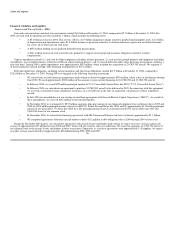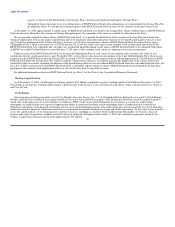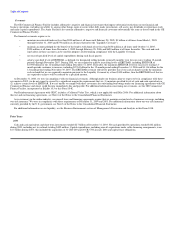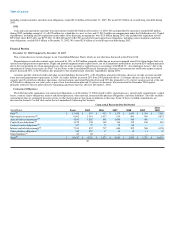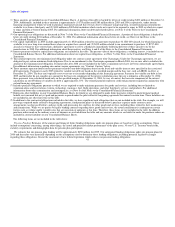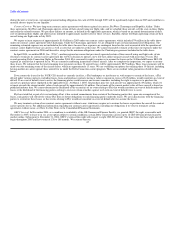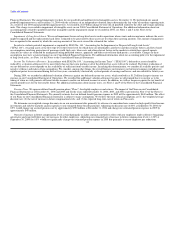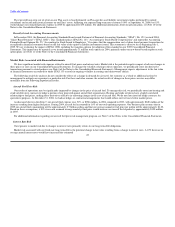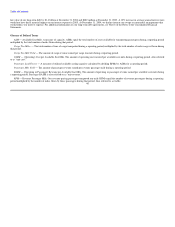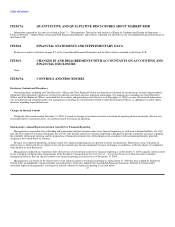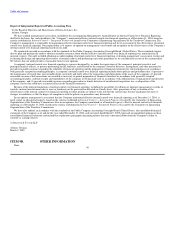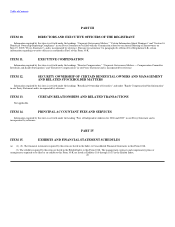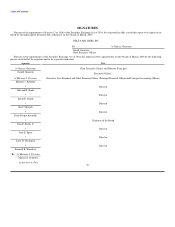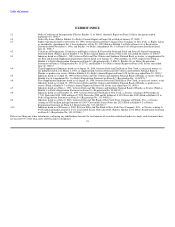Delta Airlines 2004 Annual Report Download - page 47
Download and view the complete annual report
Please find page 47 of the 2004 Delta Airlines annual report below. You can navigate through the pages in the report by either clicking on the pages listed below, or by using the keyword search tool below to find specific information within the annual report.
Table of Contents
total lease payments for these eight aircraft will be approximately $130 million during the next 14 years. Additionally, the lease rates we will pay for these
aircraft approximate current market rates. We expect to use these aircraft in our operations.
Redemptions of ESOP Preferred Stock. As discussed above, we changed the form of payment we will use to redeem shares of ESOP Preferred Stock when
redemptions are required under the Savings Plan. For the indefinite future, we will pay the redemption price of the ESOP Preferred Stock in shares of our
common stock rather than in cash. For additional information about our ESOP Preferred Stock, see Note 11 of the Notes to the Consolidated Financial
Statements.
Legal Contingencies. We are involved in legal proceedings relating to antitrust matters, employment practices, environmental issues and other matters
concerning our business. We are also a defendant in numerous lawsuits arising out of the terrorist attacks of September 11, 2001. We cannot reasonably
estimate the potential loss for certain legal proceedings because, for example, the litigation is in its early stages or the plaintiff does not specify the damages
being sought. Although the ultimate outcome of these matters cannot be predicted with certainty and could have a material adverse effect on our Consolidated
Financial Statements, management believes that the resolution of these actions will not have a material adverse effect on our Consolidated Financial
Statements.
Other Contingent Obligations under Contracts. In addition to the contractual obligations discussed above, we have certain contracts for goods and
services that require us to pay a penalty, acquire inventory specific to us or purchase contract specific equipment, as defined by each respective contract, if we
terminate the contract without cause prior to its expiration date. These obligations are contingent upon whether we terminate the contract without cause prior
to its expiration date; therefore, no obligation would exist unless such a termination were to occur.
Subsequent to December 31, 2004, we entered into an agreement to outsource certain human resources services. Under this agreement, we expect to pay a
total of approximately $120 million over the next seven years on a declining scale, with our largest annual obligation totaling approximately $20 million to be
paid in 2005. This agreement is subject to certain termination provisions.
For additional information about other contingencies not discussed above as well as discussions related to general indemnifications, see Note 8 of the
Notes to the Consolidated Financial Statements.
Application of Critical Accounting Policies
Critical Accounting Estimates
The preparation of financial statements in conformity with GAAP requires management to make certain estimates and assumptions. We periodically
evaluate these estimates and assumptions, which are based on historical experience, changes in the business environment and other factors that management
believes to be reasonable under the circumstances. Actual results may differ materially from these estimates.
Rules proposed by the Securities and Exchange Commission would require disclosures related to accounting estimates management makes in applying
accounting policies and the initial adoption of an accounting policy that has a material impact on its financial statements. These proposed rules define critical
accounting estimates as those accounting estimates which (1) require management to make assumptions about matters that are highly uncertain at the time the
estimate is made and (2) would have resulted in material changes to our Consolidated Financial Statements if different estimates, which we reasonably could
have used, were made. Our critical accounting estimates are briefly described below.
Goodwill. SFAS 142 addresses financial accounting and reporting for goodwill and other intangible assets, including when and how to perform
impairment tests of recorded balances. We have three reporting units that have assigned goodwill: Mainline, ASA and Comair. Quoted stock market prices are
not available for these individual reporting units. Accordingly, consistent with SFAS 142, our methodology for estimating the fair value of each reporting unit
primarily considers projected future cash flows. In applying this methodology, we (1) make assumptions about each reporting unit's future cash flows based
on capacity, passenger yield, traffic, operating costs and other relevant factors and (2) discount those cash flows based on each reporting unit's weighted
average cost of capital. Changes in these assumptions may have a material impact on our Consolidated
43





